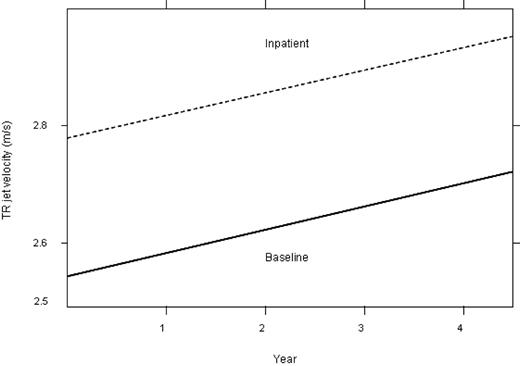Abstract
Abstract 1529
Poster Board I-552
Pulmonary hypertension (PAH) is an independent risk factor for death in sickle cell disease (SCD). We performed a retrospective chart review to determine the natural history of PAH in our adult SCD population. We hypothesized that increased pulmonary artery pressures seen during hospitalizations for painful crisis or acute chest syndrome would be reflected in a faster progression of PAH measured during steady state. We reviewed charts and echocardiograms of 362 patients seen at Duke University from January 1980 to March 2009. A total of 878 2D echocardiograms were reviewed, with 196 patients having 2 or more echocardiographic procedures. Fifth-three of the 81 patients who died during this period had had at least 2 or more echocardiograms. Studies were considered done at steady state if they were performed as an outpatient procedure. Out of 878 total echocardiograms, 460 had either no measurable tricuspid regurgitation jet (TR) or failed to report it and were excluded from further analysis, leaving 418 echocardiograms in 252 patients (167 at steady state and 251 as inpatient). Among patients with multiple echocardiograms and measurable TR jet performed at steady state, we used a linear mixed model to identify a mean yearly rate of progression of 0.04 m/s (p<0.001, 95% CI 0.02 to 0.05). Patients in whom echocardiograms were performed as inpatients had higher pressures (mean difference 0.24 m/s, p<0.01), as reported previously by other authors, but they had a similar rate of progression at steady state as did the patients without inpatient echocardiograms (Figure 1). Contrary to our hypothesis, therefore, higher inpatient TR jet velocities did not affect the rate of progression of PAH at steady state. Furthermore, the rate of progression of TR jet velocity at steady state was also not statistically significantly related to mortality (p=0.57). Interestingly, however, patients who died had an inpatient TR jet velocity slope of 0.08 m/s/year, compared to patients who were alive at the end of the study period (0.03 m/s/year, p=0.04). Furthermore, in patients with PAH, an increase in the left atrial diameter of 1 cm increased the risk of death by 50% (OR 1.47, p=0.001). Despite the potential selection bias inherent to a retrospective review, our study was able to estimate a mean progression of PAH of 0.04 m/s year in SCD patients at steady state and to identify increasing left atrium enlargement as a strong predictor of death. In this cohort, findings of a faster progression of PAH, measured by inpatient echocardiograms, did not correlate with changes in the rate of progression of PAH at steady state, although it was associated with an increased risk of death. Improved knowledge of variables characterizing the natural history of PAH in SCD patients should support further development of therapeutic approaches targeting PAH.
No relevant conflicts of interest to declare.
Author notes
Asterisk with author names denotes non-ASH members.


This feature is available to Subscribers Only
Sign In or Create an Account Close Modal